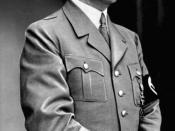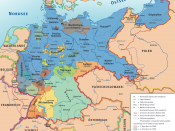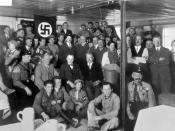Select the ruler of one single party state (Hitler) and assess the conditions of the previous regime that the ruler replaced (Weimar) and the nature of support that helped the ruler to achieve power.
In 1920 Hitler emerged as leader of NSDAP. In August 1934, President Hindenburg dies and Hitler becomes President. The Weimar Republic was unpopular, because the Germans had never had a democratic government and thought it was weak. There are many reasons why Hitler and the Nazi Party managed to establish power in Germany.
The rise of Hitler can be explained in two ways: the weaknesses of the Weimar Republic and the strengths of the Nazis. First of all, there was no popular support for Weimar. By signing the Armistice in November1919, the Weimar politicians became known as the November Criminals. The people of Germany didn't want a democracy, they wanted a strong government and support for the extreme left and the extreme right increased.
The Weimar government was characterised by Proportional Representation, which meant that no party could have total control and the Reichstag would consist of weak coalitions instead of strong and autocratic. It was also marked by article 48, which was an article that stated that the President could rule by decree in case of an emergency. It was likely that this article would be used, because weak coalition governments could not solve the problems that Germany faced after the war.
The Weimar government faced uprisings, even before the Treaty of Versailles had been signed. An example of this is the Spartacist movement in 1919, led by Rosa Luxemburg and Karl Liebknecht, which could only be crushed by the Freikorps. After the Treaty of Versailles, there was the Kapp Putch in 1920, led by Wolfgang Kapp. This was an uprising of the Freikorps...



Interesting
But if the United States did not aid in the weakness of the republic and did not help in the demise of the Monarchy then hitler would of never risen. Democracy actually comes from Monarchy's contrary to what people believe. So the Weimar government was weak for tryin to "mock" the United States. The people thought the republic was weak because it could not get all the abundant natural resources the U.S. has immediate access to, and thus, power. Take away all the natural resources of the United states and you have yourself a third world nobody.
2 out of 2 people found this comment useful.